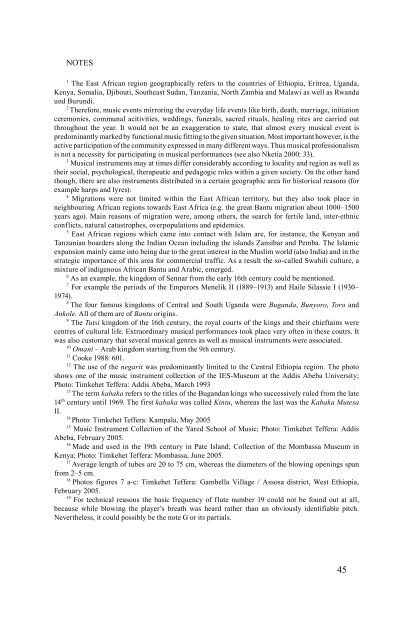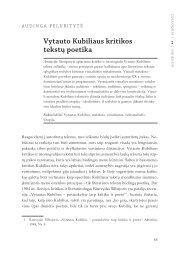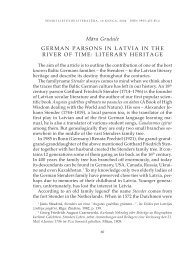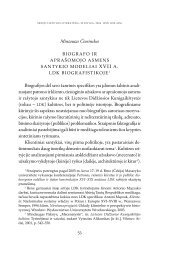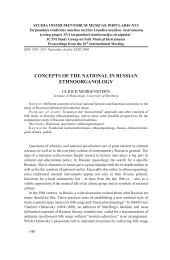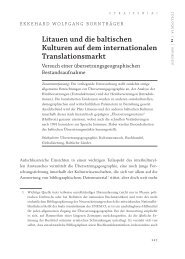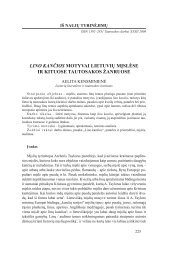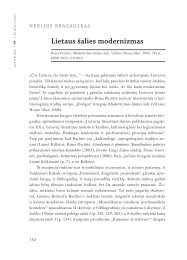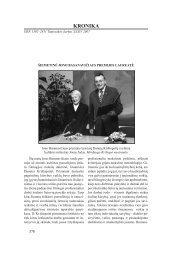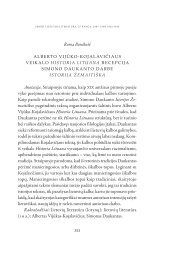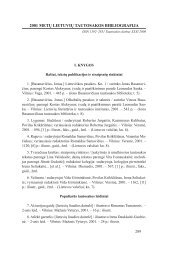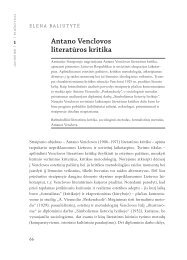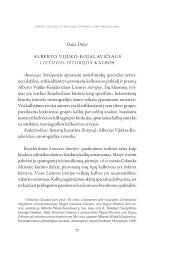tautosakos darbai xxxii - Lietuvių literatūros ir tautosakos institutas
tautosakos darbai xxxii - Lietuvių literatūros ir tautosakos institutas
tautosakos darbai xxxii - Lietuvių literatūros ir tautosakos institutas
You also want an ePaper? Increase the reach of your titles
YUMPU automatically turns print PDFs into web optimized ePapers that Google loves.
NoTes<br />
1 the east african region geographically refers to the countries of ethiopia, eritrea, uganda,<br />
kenya, somalia, djibouti, southeast sudan, tanzania, north Zambia and Malawi as well as rwanda<br />
und Burundi.<br />
2 therefore, music events m<strong>ir</strong>roring the everyday life events like b<strong>ir</strong>th, death, marriage, initiation<br />
ceremonies, communal acitivities, weddings, funerals, sacred rituals, healing rites are carried out<br />
throughout the year. it would not be an exaggeration to state, that almost every musical event is<br />
predominantly marked by functional music fitting to the given situation. Most important however, is the<br />
active participation of the community expressed in many different ways. thus musical professionalism<br />
is not a necessity for participating in musical performances (see also nketia 2000: 33).<br />
3 Musical instruments may at times differ considerably according to locality and region as well as<br />
the<strong>ir</strong> social, psychological, therapeutic and pedagogic roles within a given society. on the other hand<br />
though, there are also instruments distributed in a certain geographic area for historical reasons (for<br />
example harps and lyres).<br />
4 Migrations were not limited within the east african territory, but they also took place in<br />
neighbouring african regions towards east africa (e.g. the great Bantu migration about 1000–1500<br />
years ago). Main reasons of migration were, among others, the search for fertile land, inter-ethnic<br />
conflicts, natural catastrophes, overpopulations and epidemics.<br />
east african regions which came into contact with islam are, for instance, the kenyan and<br />
tanzanian boarders along the indian ocean including the islands Zansibar and Pemba. the islamic<br />
expansion mainly came into being due to the great interest in the Muslim world (also india) and in the<br />
strategic importance of this area for commercial traffic. as a result the so-called swahili culture, a<br />
mixture of indigenous african Bantu and arabic, emerged.<br />
6 as an example, the kingdom of sennar from the early 16th century could be mentioned.<br />
7 For example the periods of the emperors Menelik ii (1889–1913) and Haile silassie i (1930–<br />
1974).<br />
8 the four famous kingdoms of Central and south uganda were Buganda, Bunyoro, Toro and<br />
Ankole. all of them are of Bantu origins.<br />
9 the Tutsi kingdom of the 16th century, the royal courts of the kings and the<strong>ir</strong> chieftains were<br />
centres of cultural life. extraordinary musical performances took place very often in these coutrs. it<br />
was also customary that several musical genres as well as musical instruments were associated.<br />
10 Omani – arab kingdom starting from the 9th century.<br />
11 Cooke 1988: 601.<br />
12 the use of the negarit was predominantly limited to the Central ethiopia region. the photo<br />
shows one of the music instrument collection of the ies-Museum at the addis abeba university;<br />
Photo: timkehet teffera: addis abeba, March 1993<br />
13 the term kabaka refers to the titles of the Bugandan kings who successively ruled from the late<br />
14 th century until 1969. the f<strong>ir</strong>st kabaka was called Kintu, whereas the last was the Kabaka Mutesa<br />
ii.<br />
14 Photo: timkehet teffera: kampala, May 2005<br />
1 Music instrument Collection of the Yared school of Music; Photo: timkehet teffera: addis<br />
abeba, February 2005.<br />
16 Made and used in the 19th century in Pate island; Collection of the Mombassa Museum in<br />
kenya; Photo: timkehet teffera: Mombassa, June 2005.<br />
17 average length of tubes are 20 to 75 cm, whereas the diameters of the blowing openings span<br />
from 2–5 cm.<br />
18 Photos figures 7 a-c: timkehet teffera: gambella village / assosa district, West ethiopia,<br />
February 2005.<br />
19 For technical reasons the basic frequency of flute number 19 could not be found out at all,<br />
because while blowing the player’s breath was heard rather than an obviously identifiable pitch.<br />
nevertheless, it could possibly be the note g or its partials.<br />
45


